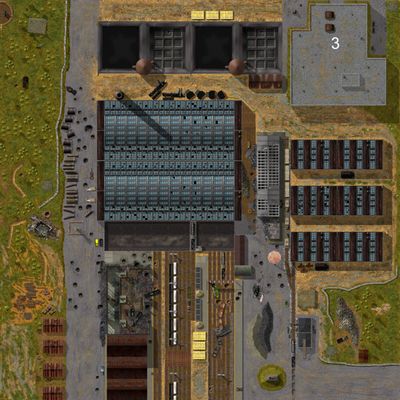Screenshots from all Close Combat versions.

|
|
The Kharkov Locomotive Factory (KhPZ)
|
The Kharkov Locomotive Factory (KhPZ) built about 20% of the Russian Empire's railway engines. After the Russian Revolution and the establishment of the Soviet government in Ukraine, the factory was put to work designing and building tractors, then tanks after 1927. The Bolshevik Factory in Leningrad and the KhPZ were the first two Soviet tank factories, modernized in 1929 with German assistance under the Treaty of Rapallo, 1922.
In 1928, a tank design bureau was established in the factory, one of several which would be responsible for the some of the most successful tanks ever built, and eventually become the Morozov Design Bureau. The KhPZ designed and produced twenty-five T-24 tanks, then nearly eight thousand BT fast tanks. It also built a handful of multi-turreted T-35 tanks.
Shortly before the German invasion of the Soviet Union the KhPZ started series production of the T-34, the most-produced and arguably best tank of WWII. Series production began in June 1940 in Kharkiv, and later in the Stalingrad Tractor Plant and Sormovo Shipbuilding Plant. In 1941, due to German advances, the factory and design shops were evacuated to the Ural mountains. The plant was united with Uralvagonzavod Plant in Nizhny Tagil into one enterprise called Uralskiy Tank Plant No.183.
When Kharkiv was recaptured, it began production of the new T-44 tank in 1945, and the first prototypes of the T-54 were built. After the war was over, the design bureau and factory gradually transferred all operations back to Ukraine. T-54 production was started in the Urals and Kharkiv in 1947–48, and the move ended with the 1951 re-establishment of the Design Bureau, now called KB-60M, in Kharkiv. The Factory No. 183 designation was left in Nizhny Tagil, and the Factory in Kharkiv was now called Factory No. 75, renamed Malyshev Plant in 1957. The factory built tank engines, and later took up production of T-54, T-55 (1958, the most-produced tank ever), and T-64 (1967) tanks. The T-64 was also built in the Leningrad Kirov Plant and Uralvagonzavod Plant. In the 1960s the bureau also designed OT-54 and TO-55 flame-thrower tanks, for production at the Omsk Transport Machine Construction Plant. The T-80 tank, with a high-performance gas turbine engine was produced beginning in 1983, and T-80UD (more conventional diesel model) in 1985.
Finished tanks were assembled in several plants, but Soviet industrial planning was planned to prevent any region from being able to establish independent arms production. Components and subassemblies were produced in different factories, the Malyshev Factory specializing in engines and transmissions.
|
|
|
|
|
Awesome work! So this is for the final version of Kharkov? Can't wait, Ironcross1!
|



